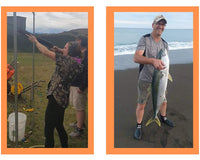Picking out the right knife can be overwhelming. It’s best to ask yourself these questions when trying to make a decision on what to purchase for your tackle box or hunting bag. The legends and Buck Knives have put together this handy guide to help you choose:
WHAT DO YOU WANT IN A KNIFE?
- How will you use your knife?
- What features are important to your activities?
- What materials are most critical to the use?
- What safety features do you expect?
WHAT FEATURES ARE IMPORTANT TO YOUR ACTIVITIES?
- Fixed-blade - sturdy, dependable, always ready for use.
- Folding knife - compact, safe to carry. Most lock open for safe use.
- Blade Shape – what shape best serves your needs. See our blade shape section for more info
- One-hand open/close - essential when one hand is occupied.
- Thick blade - heavy-duty tasks.
- Lightweight - feel unencumbered, easier in your pocket.
- Gut hook - field dressing/skinning game.
- Saw tooth - cutting wood or bone.
- Ergonomic design - fits your hand comfortably.
WHAT IS IT MADE OF? WHAT MATERIALS ARE CRITICAL TO YOUR USE?BLADE STEEL A good blade combines good edge retention, rust resistance and ease of re-sharpening. -
- 420HC is a stainless steel that provides excellent rust resistance, ease of re-sharpening and medium edge retention.
- 154CM is a custom steels with much higher carbon content, giving it a higher hardness ratings and dramatically higher edge retention.
- S30V is a high vanadium stainless steel with even higher edge retention.
HANDLE MATERIALS
- Rubber, Micarta and textured handles provide a superior grip in wet conditions.
- Wood and metal handles provide durability and aesthetics.
- Composite handles provide fit, grip and durability.
- Would you prefer a knife that locks open? Locks open and closed?
- What type of locking mechanism makes you feel the most comfortable? See Fixed vs Folding for locking mechanisms
- For a fixed blade, would you prefer a larger blade guard? Also consider handle materials for a better grip depending on its intended use.
First, you must decide between a fixed blade or folding blade. Fixed blades are heavy duty, easy to clean and easily accessed with a sheath. Folders are very safe; most lock open and won't accidentally open in your pack or close on your hand. They may be harder to clean and you have to be careful of keeping the folding mechanisms clean, but they are easier and more convenient to carry. Whether you decide on a fixed blade or folder, you also need to pick a blade shape and steel that best suits your needs.
BLADE SHAPES
Another thing to consider when choosing a knife is the blade shape. What shape will work best for your needs? Below are the most common blade styles.
DROP POINT This blade is full bellied with a strong, thick point for heavier tasks. It can also be used as a general work knife. The top of the blade drops down toward the tip, which minimises accidental puncturing while skinning. The drop point blade is strong and very versatile.

MODIFIED TANTO Holding many of same features as the regular tanto blade, the angled point is modified between the front edge and the bottom edge on this particular blade. Holds up to piercing, scraping, and prying with tough materials.
TANTO Very strong for heavy duty use. Holds up to piercing, scraping and prying with tough materials. Many tactical knives utilise this blade shape.

SKINNER Best suited for skinning game. The tip is narrow, while the wide curved belly gives a nice skinning sweep that aids in getting through thick layers. The downward angled, more blunt point makes it harder to make an accidental slice through the hide.

PEN This is a smaller version of the larger "spear point" blade. Pen blades are usually on pocket knives as a handy, all-purpose blade.

COPING A narrow blade with a sharp, angular point, it is designed to be used for cutting in tight spots or curved patterns, much as you would with a coping saw, only without the teeth.

CLIP The crescent tip makes the blade thinner with a sharper point. This shape provides good control for detail work and cutting in tight places. It is also well suited for intentional punctures like new holes in your belt, etc. While the point of the blade is effective for detail work, it's not as strong as the thicker points on drop points and skinners.

CAPING Almost scalpel-like in shape, it has a mild drop point, with nearly a spear tip that is used for the delicate removal of the hide of the face of a trophy animal. The shape makes caping knives perfect choices for birds and small game. Caping knives tend to be slim and very light duty so they are not always a right choice if you only intend to carry a single knife.

SERRATIONS Serrations give your Buck blade greater cutting power. Especially useful when cutting line and/or cables.

GUT HOOK For great performance when field dressing game, a gut or skinning hook is an ideal tool. We’ve paid careful attention to the angles on the sharpened edge, shape and size of the entry opening and location of the hook on the blade, making a Buck gut hook the best.

Still need help deciding? Give us a call or get in touch on socials, we will help set you up with what you need.




